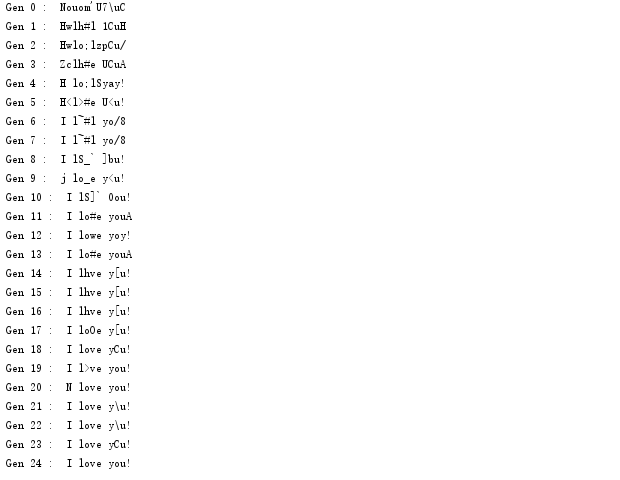Source of original code
Author: Morvan
Visualize Genetic Algorithm to match the target phrase.
Visit tutorial website for more: https://morvanzhou.github.io/tutorials/
The result

Absolutely, it's satisfying.
With only 24 generations(Maybe a little more or less, randomly.), the sentence matches perfectly.
Algorithm & Code interpretation
the code component
The whole code is consists of three parts.
Some const variables , the class GA and the main function.
some const variables
TARGET_PHRASE = 'I love you!' # target DNA
POP_SIZE = 300 # population size
CROSS_RATE = 0.4 # mating probability (DNA crossover)
MUTATION_RATE = 0.01 # mutation probability
N_GENERATIONS = 1000 # max generation
DNA_SIZE = len(TARGET_PHRASE) # the size of DNA
# target ASCII indices of the target string, convert string to number
TARGET_ASCII = np.fromstring(TARGET_PHRASE, dtype=np.uint8)
ASCII_BOUND = [32, 126] # the bounds of the ASCII charactors
main function
Firstly, we constuct a GA object ,named ga with the const variables above.
ga = GA(DNA_size=DNA_SIZE, DNA_bound=ASCII_BOUND, cross_rate=CROSS_RATE,
mutation_rate=MUTATION_RATE, pop_size=POP_SIZE)
Then, execute a for loop in the max generation
for generation in range(N_GENERATIONS):
fitness = ga.get_fitness() # get the fitness of the current population
best_DNA = ga.pop[np.argmax(fitness)] # best matching DNA
best_phrase = ga.translateDNA(best_DNA) # translate the DNA to string we can read
print('Gen', generation, ': ', best_phrase) # print the string
if best_phrase == TARGET_PHRASE: # as if the string matches perfectly, break the loop
break
ga.evolve() # if not, evolve to the next generation
GA class
function init()
def __init__(self, DNA_size, DNA_bound, cross_rate, mutation_rate, pop_size):
self.DNA_size = DNA_size # the size of DNA
DNA_bound[1] += 1
self.DNA_bound = DNA_bound # ASCII Bound
self.cross_rate = cross_rate
self.mutate_rate = mutation_rate
self.pop_size = pop_size # population
# define the population of first generation
self.pop = np.random.randint(*DNA_bound, size=(pop_size, DNA_size)).astype(np.int8) # int8 for convert to ASCII
To initialize the class with const variables above
function translateDNA()
def translateDNA(self, DNA):
# convert to readable string
return DNA.tostring().decode('ascii')
Such as translate
[126, 34, 45, 125, 46, 101, 32, 119, 38, 126, 33] to '~"-}.e w&~!'
function get_fitness()
def get_fitness(self): # count how many character matches
match_count = (self.pop == TARGET_ASCII).sum(axis=1)
return match_count
To calculate the fitness of every DNA in current generation.
List of array convert to list of int , int means match numbers
function select()
def select(self):
fitness = self.get_fitness() + 1e-4 # add a small amount to avoid all zero fitness
idx = np.random.choice(np.arange(self.pop_size), size=self.pop_size, replace=True, p=fitness/fitness.sum())
return self.pop[idx]
To select better fit DNA
Every new array element depends on the probabilities of old array elements
(probability = element.fitness/fitness.sum())
The probability is higher, the more it will appear in the new array
function crossover()
def crossover(self, parent, pop):
if np.random.rand() < self.cross_rate:
i_ = np.random.randint(0, self.pop_size, size=1) # select another individual from pop
cross_points = np.random.randint(0, 2, self.DNA_size).astype(np.bool) # choose crossover points
parent[cross_points] = pop[i_, cross_points] # mating and produce one child
return parent
To cross this parent with another random parent in current generation
function mutate()
def mutate(self, child):
for point in range(self.DNA_size):
if np.random.rand() < self.mutate_rate:
child[point] = np.random.randint(*self.DNA_bound) # choose a random ASCII index
return child
Traverse all the elements in a DNA
Randomly convert a element to a random ASCII charactor index
function evolve()
def evolve(self):
pop = self.select()
pop_copy = pop.copy()
for parent in pop: # for every parent
child = self.crossover(parent, pop_copy)
child = self.mutate(child)
parent[:] = child
self.pop = pop
To evolve into the next generation.
Firstly, select the better fitting ones
Then, creat a copy of current generation
Then, traverse everyone in current generation,
cross it with another random one in current generation
mutate randomly.
Finally, upgrade to the next generation
Complete code
import numpy as np
TARGET_PHRASE = 'I love you!' # target DNA
POP_SIZE = 300 # population size
CROSS_RATE = 0.4 # mating probability (DNA crossover)
MUTATION_RATE = 0.01 # mutation probability
N_GENERATIONS = 1000
DNA_SIZE = len(TARGET_PHRASE)
TARGET_ASCII = np.fromstring(TARGET_PHRASE, dtype=np.uint8) # convert string to number
ASCII_BOUND = [32, 126]
class GA(object):
def __init__(self, DNA_size, DNA_bound, cross_rate, mutation_rate, pop_size):
self.DNA_size = DNA_size
DNA_bound[1] += 1
self.DNA_bound = DNA_bound
self.cross_rate = cross_rate
self.mutate_rate = mutation_rate
self.pop_size = pop_size
self.pop = np.random.randint(*DNA_bound, size=(pop_size, DNA_size)).astype(np.int8) # int8 for convert to ASCII
def translateDNA(self, DNA): # convert to readable string
return DNA.tostring().decode('ascii')
def get_fitness(self): # count how many character matches
match_count = (self.pop == TARGET_ASCII).sum(axis=1)
return match_count
def select(self):
fitness = self.get_fitness() + 1e-4 # add a small amount to avoid all zero fitness
idx = np.random.choice(np.arange(self.pop_size), size=self.pop_size, replace=True, p=fitness/fitness.sum())
return self.pop[idx]
def crossover(self, parent, pop):
if np.random.rand() < self.cross_rate:
i_ = np.random.randint(0, self.pop_size, size=1) # select another individual from pop
cross_points = np.random.randint(0, 2, self.DNA_size).astype(np.bool) # choose crossover points
parent[cross_points] = pop[i_, cross_points] # mating and produce one child
return parent
def mutate(self, child):
for point in range(self.DNA_size):
if np.random.rand() < self.mutate_rate:
child[point] = np.random.randint(*self.DNA_bound) # choose a random ASCII index
return child
def evolve(self):
pop = self.select()
pop_copy = pop.copy()
for parent in pop: # for every parent
child = self.crossover(parent, pop_copy)
child = self.mutate(child)
parent[:] = child
self.pop = pop
if __name__ == '__main__':
ga = GA(DNA_size=DNA_SIZE, DNA_bound=ASCII_BOUND, cross_rate=CROSS_RATE,
mutation_rate=MUTATION_RATE, pop_size=POP_SIZE)
for generation in range(N_GENERATIONS):
fitness = ga.get_fitness()
best_DNA = ga.pop[np.argmax(fitness)]
best_phrase = ga.translateDNA(best_DNA)
print('Gen', generation, ': ', best_phrase)
if best_phrase == TARGET_PHRASE:
break
ga.evolve()